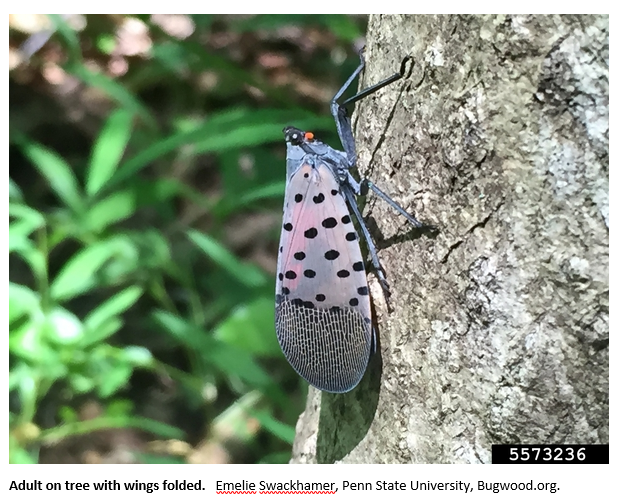Lanternflies Have Arrived in NC! Not Good News!!
go.ncsu.edu/readext?872892
en Español / em Português
El inglés es el idioma de control de esta página. En la medida en que haya algún conflicto entre la traducción al inglés y la traducción, el inglés prevalece.
Al hacer clic en el enlace de traducción se activa un servicio de traducción gratuito para convertir la página al español. Al igual que con cualquier traducción por Internet, la conversión no es sensible al contexto y puede que no traduzca el texto en su significado original. NC State Extension no garantiza la exactitud del texto traducido. Por favor, tenga en cuenta que algunas aplicaciones y/o servicios pueden no funcionar como se espera cuando se traducen.
Português
Inglês é o idioma de controle desta página. Na medida que haja algum conflito entre o texto original em Inglês e a tradução, o Inglês prevalece.
Ao clicar no link de tradução, um serviço gratuito de tradução será ativado para converter a página para o Português. Como em qualquer tradução pela internet, a conversão não é sensivel ao contexto e pode não ocorrer a tradução para o significado orginal. O serviço de Extensão da Carolina do Norte (NC State Extension) não garante a exatidão do texto traduzido. Por favor, observe que algumas funções ou serviços podem não funcionar como esperado após a tradução.
English
English is the controlling language of this page. To the extent there is any conflict between the English text and the translation, English controls.
Clicking on the translation link activates a free translation service to convert the page to Spanish. As with any Internet translation, the conversion is not context-sensitive and may not translate the text to its original meaning. NC State Extension does not guarantee the accuracy of the translated text. Please note that some applications and/or services may not function as expected when translated.
Collapse ▲My mother told me that if you don’t have anything good to say, don’t say anything. Therefore, I’m just going to write this article, and you will have to read it on your own. There is nothing good to say at this point.
The spotted lanternfly was found and identified officially in June 2022 in Forsyth County, NC! A whole established colony of them. That is not good news for any of us. (This is when you should stop reading, gasp, and ask… what does that mean to me???)
That means that these invaders, originally from China, are getting much closer to paradise (Lincoln County) with their nasty habits. These pests will practically cover the trunk and branches of a tree (see photo), and suck sap from the plant. Then, after using very little of the sugary liquid they take from the tree for energy, they squirt the remainder out of their bodies where it falls to the ground like a light rain! It is pretty disgusting if you think about it, and so if you ever visit one of our already infested sister states like Pennsylvania on a clear day, and you feel it raining on you under a tree on a clear day…DON’T THINK ABOUT IT!
The Spotted Lantern Fly first showed up in Pennsylvania in 2014, and then in 9 more states by the time 2021 ended. It is a problem for production agricultural and for ornamental woody plants in landscapes. They are particularly rough on grapevines. They are also bad news for many common fruit trees.
Trees tend to survive attacks, BUT, they are weakened by the loss of nutrients, reduction of photosynthesis, and robbing the plant of the energy stored through photosynthesis. This can cause them to decline, and even fail with time.
Another issue that arises with an invasion of the spotted lanternfly, is the growth of sooty mold on the plant. Sooty mold is a fungus that grows on honeydew (the sticky, clear liquid expelled by the lanternflies). Too much sooty mold makes for an ugly black-looking plant, and can actually black out enough of the sun from leaves to reduce the all-important photosynthesis.
If you think you have found these insects, I suggest that you go straight to the NC Department of Agriculture with a report. The NC Department of Agriculture & Consumer Services is ready to counter attack if a population is found. Reports should be sent to badbug@ncagr.gov. We can help you confirm that they are lanternflies, but the NCDA does the eradication! (For more information. ) 
Let’s all be alert, and on guard!




